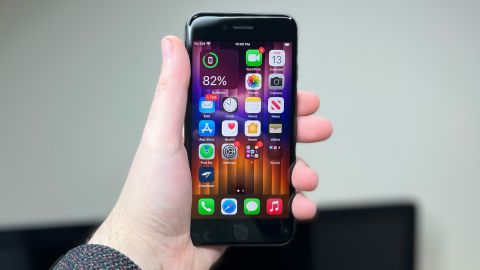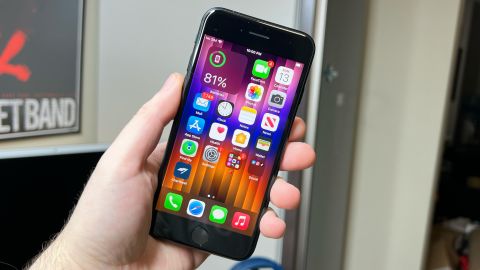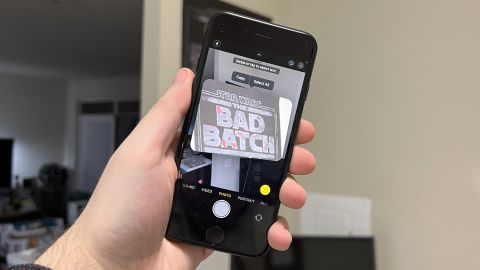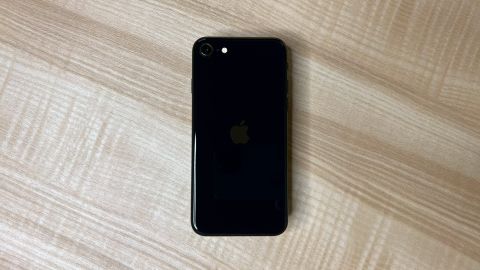The iPhone SE is Apple’s budget-friendly iPhone and pairs an older design with newer hardware. The third-generation iPhone SE is now up for preorder and continues this working formula.
It’s now $429 — a slight price bump over previous models — in an identical build with a home button and just a single camera lens. But it’s upgraded on the inside with a newer processor and support for 5G. And I’ve spent six days with it to see who needs to upgrade and determine who the budget iPhone is for.
The who, what and how
Who this is for: If you’re looking for your first smartphone or holding onto an older iPhone (first-gen SE, 6, 6S, 7 or 8), the iPhone SE delivers plenty of performance, the ability to take great photos and a compact size for $429. Those who want a more modern device with a larger screen can look at the $599 iPhone 11 or a refurbished iPhone.
What you need to know: At $429 the iPhone SE gets you the power and performance of the iPhone 13 in a smaller build with a 4.7-inch display and just a single camera. It’s not for someone who wants the most versatile photography experience or a screen for binging a TV show season on the go. You do get modern performance which bests nearly all other budget phones and stretches the potential life of this phone.
How this compares: The iPhone SE performs just as well as the iPhone 13, thanks to the same processor being used at a fraction of the price. It lets you complete nearly any thinkable task on the phone. When compared to another budget phone, like the Pixel 5a with 5G, the SE is quicker to open apps and feels more fluid for intense tasks like gaming.The onboard cameras meet the level of iPhone quality with most shots, but there’s not a dedicated night mode which is disappointing. You’ll need to use the flash, which doesn’t deliver the greatest shots in low-lighting conditions and can lead to overexposure of a shot, or extra noise in an image. The Pixel 5a with 5G wins out with a dedicated “Night Sight” mode which uses software for clear, crisp shots in those conditions. t. It’s not a wash though, the iPhone SE is a mostly compromise-free experience and delivers what you expect from an iPhone at a budget price.
Classic iPhone design with a 4.7” screen

The iPhone SE sticks with a classic iPhone design that’s identical to the second-generation and . truthfully resembles an iPhone 8. It’s a glass front and back with aluminum sides. The 4.7-inch Retina HD display is surrounded by bezels with a home button below the screen for easy unlocking through Touch ID.. Like on the second-gen, the home button is an electronic one powered by a haptic motor — so when the phone is dead or off, the button won’t click in.
The iPhone SE is comfortable to hold and can easily be used with just one finger. That’s refreshing and can’t be said about the iPhone 13 Pro Max. And holding it next to an iPhone 13 Pro Max makes it seem downright miniature.
The back glass is upgraded here for added durability. Apple says it’s the same glass found on the iPhone 13 and that should help prevent it from cracks and scratches. The SE is IP67 rated against water and dust resistance, and it survived a full dunk into a glass of water.
Apple didn’t opt to add MagSafe wireless charging support here. This proprietary charging tech debuted on the iPhone 12 but ensures proper alignment with compatible wireless chargers thanks to magnets. While I get Apple is using a similar design style — and likely the same parts — it would have been nice to see this added in for more wireless charging options.

The 4.7-inch Retina HD screen is unchanged and that’s not really a bad thing. It’s still a classic LCD display, so it won’t offer the same vibrant colors and deep contrast points as an OLED in an iPhone 13 or even the Pixel 5a with 5G. Still though, it’s been great for navigating iOS, watching TikToks, typing on the fly and watching shows.
The iPhone SE’s screen is bit small for taking in a full-length film, however, and it’s hard to get fully immersed. Especially if you’re coming from a larger device. I’s also only a 60Hz refresh rate screen, which means you won’t get the same smooth scrolling experience as you’ll enjoy on 120Hz phones like the iPhone 13 Pro and Google Pixel 6. The SE’s display also looks dated compared to more borderless screens that opt for a notch or a pinhole.
Lastly, since this is the same build, second-generation iPhone SE cases and iPhone 8 cases fit this device just fine.
Same camera lens, new smarts

The 2022 iPhone SE features a primary 12-megapixel lens on the back, and that’s unchanged from the second-gen. With Apple’s A15 Bionic chip inside, this lens works with a new image signal processor that speeds up shooting photos or recording videos and adds in new processing modes (Smart HDR4 and Deep Fusion). Both aren’t necessarily evident, but lead to clearer images and let the SE better identify what you’re trying to capture in a shot.
All of this works to make this 12-megapixel a sharpshooter. You’ll need to work to set up a shot right, though — given that it’s only a wide lens, if you want to capture more, you’ll need to move back physically. And while it has digital zoom, we’d recommend physically getting closer to an object to avoid blur. It’s quick to shoot, generally able to capture a photo in under a second for most conditions.
The iPhone SE can still shoot Portrait Mode with a single lens, but it’s just for people. That means no photos of pooches, cats or inanimate objects. It still performs well on the SE, and it’s gotten better at figuring out when to start the effect on. There is a noticeable improvement over shots from the second-gen SE, and the latest iPhone SE is on par with the Pixel 5a with 5G for these shots.
Photographic Styles, which first premiered on the iPhone 13, have arrived on the iPhone SE These let you customize how the iPhone shoots, whether you want to up the vibrancy or lower the contrast. It’s a filter on steroids and it doesn’t slow down the SE. It’s fast to capture an image in your desired style and in some cases, it’s faster at capturing the shot with a Photographic Style than an iPhone 13.
The latest iPhone SE is quicker at identifying the focus (or multiple focuses) to be ready to capture an image within an instant. Processing is faster than the second generation, but coming from an iPhone 8 or even an original iPhone SE will deliver some pretty big boosts.
It doesn’t have every feature though — there’s no Night Mode on the iPhone SE, and it shows with lower-light photos. Rather than extending the capture time and using AI to boost the scene’s lighting, the iPhone SE uses software and a standard LED flash to light the scene. This leads to longer capture times and it’s not instant for capturing nighttime shots. You can still get a good result, but it’s not as good as other phones even in this price range. The Pixel 5a with 5G does a much better job at capturing these shots. It extends the capture time in its Night Sight mode and uses software to make them look dynamically lighter without reducing the image quality.
Above the screen on the front is a 7-megapixel FaceTime camera that leaves you with color-accurate selfies and crisp details. It can even take Portrait Mode selfies and is excellent for video calls.
iOS here is just as smooth as any iPhone 13

The iPhone SE is powered by the Apple-made A15 Bionic chip, which is the same processor found in the iPhone 13 line. This $429 iPhone opens apps fast, edit images and multitask without the device heating up or slowing down. It’s the uncompromised iPhone experience, and that’s a critical mark to meet at this price.
I had no issues FaceTiming while completing other tasks, whether it was playing a game or even editing a photo in Afterlight. I could also take advantage of Live Text within the camera. If you’re holding the iPhone SE at a sign in front of a store, you can quickly grab the name, address, and phone number. You can tap on it, highlight it and interact with the text. It doesn’t slow down at all.
I also ran the premium flagship through Geekbench 5, which measures general performance. The latest iPhone SE clocks in with a 1,727 single-core and a 4,680 multi-core score, which surpasses the previous iPhone SE and is in line with the iPhone 13 family.
|
GeekBench 5 Single-Core
|
GeekBench 5 Multi-Core
|
||
|---|---|---|---|
| iPhone SE third-generation | Apple A15 Bionic | 1,727 | 4,680 |
| iPhone SE second-generation | Apple A13 Bionic | 1,330 | 2,434 |
| iPhone 13 | Apple A15 Bionic | 1,667 | 4,465 |
| iPhone 13 Pro Max | Apple A15 Bionic | 1,739 | 4,675 |
Unlike other Android phones or even the Pixel 5a with 5G, which uses an older – and slower – Qualcomm Snapdragon processor, the SE is powered by a processor used in flagship smartphones. It runs iOS 15.4 very smoothly and will likely handle any future version of the iOS quite well. I’d also call out that the original iPhone SE (released in 2016) is still receiving iOS updates and does run iOS 15.4, so you should be able to count on the new model being supported for many years to come.

The efficiencies of the A15 Bionic spread over into battery life. Apple says it’s packed a bigger battery into the third-generation iPhone SE and that you can expect 15 hours of video playback. That’s five hours more than what Apple promised for the second-gen, which lasted for nine hours and 20 minutes in our testing.
I was able to make it through a full day before the iPhone SE gave me a low battery warning. That averaged out to about 6 hours of screen on time, which is pretty solid, but doesn’t come close to the 13-plus hours we got from the Pixel 5a with 5G. On our battery test — which is a looped a 4K video — the third-generation iPhone SE lasted for 11 hours and 20 minutes.
5G arrives on the iPhone SE

The affordable iPhone now supports the 5G bands that AT&T, T-Mobile or Verizon offer most widely across the United States. The third-generation iPhone SE supports 5G Sub-6 — this is a network that’s easier to deploy, but it delivers speeds closer to 4G LTE with more room for the device to stay on the network. A good comparison is a highway with more lanes: 4G LTE is a 4-lane highway and 5G Sub-6 is a 6-lane highway. I accessed Sub-6 and found it to be perfectly fine, but nothing remarkably crazy. 5G also didn’t cause a big hit on battery life here.
While I couldn’t test it, the iPhone SE supports 5G via C-Band networks which claim to offer much faster speeds than 4G LTE or 5G Sub-6. You can also choose to use a physical SIM card or an E-SIM on the iPhone SE.
There is no support for mmWave 5G networks on the iPhone SE and this is the network to hit the “promised” and “advertised” super-fast speeds on a mobile network that can reach higher than a gigabit (1,000MBps) home network. You’ll need to pay up and get an iPhone 12 or 13 to access that network on an iPhone.
Bottom line
At $429, the third-generation iPhone SE is nearly a compromise-free budget phone experience. For the price, you get a device that behaves and performs like a modern iPhone in a petite build with a classic design. If you’re alright without multiple camera lenses and a big screen with a super-fast refresh rate, the SE deserves a look considering it doesn’t require you to compromise on much else.
The iPhone SE should last for many years and could be an excellent first phone for someone. It’s also a worthy upgrade for those with a first-generation iPhone SE or an older iPhone 6, 6S, 7 or 8. I wouldn’t necessarily recommend jumping down from a Face ID-enabled device or a larger iPhone without seeing it in person. It is very tiny, after all.
There’s no immediate need to upgrade if you have the second-generation iPhone SE. That’s still an incredibly well-performing device, and I wish Apple had kept it in the line as an even more affordable model. But the iPhone SE gives you the performance of a much more expensive phone in a compact size, and has enough power and features to be future-proof for years to come.
Source: www.cnn.com

